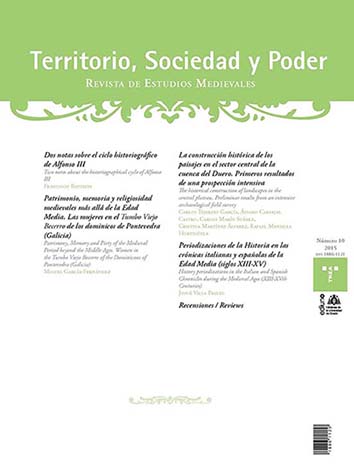Resumen
Resumen El objetivo del presente trabajo es reflexionar sobre el Tumbo Viejo Becerro, un inventario de escrituras iniciado en 1568 a través del cual podemos conocer cuestiones relativas a los patrimonios, memoria y religiosidad medievales más allá de la Edad Media. A pesar de no contener documentos medievales íntegros, constituye una fuente muy útil para poner de manifiesto la importancia de las mujeres en la sociedad bajomedieval gallega. Por ello, se hace un estudio cuantitativo y cualitativo para determinar la presencia y participación de las mujeres en las escrituras inventariadas. Todo ello apunta a la necesidad de superar las visiones pesimistas que solo insisten en el androcentrismo de las fuentes medievales para apostar decididamente por un discurso histórico que destaque el papel de las mujeres como propietarias, guardianas de la memoria propia y familiar, y piezas clave en la religiosidad de la Edad Media.
Palabras clave: Baja Edad Media. Galicia. Mujeres. Memoria. Patrimonio. Religiosidad. Tumbo Viejo Becerro
Abstract The aim of this paper is to reflect on the information that has been preserved on the Middle Ages in sources of the Early Modern Period, in this case in a tumbo from the Galician convent of Santo Domingo de Pontevedra (AHN, Clero, L. 10239). The Tumbo Viejo Becerro was started by the prior Fray Juan de Manzanas in 1568 and continued by Fray Alonso Gasco in 1597. It is an inventory of deeds through which we can study issues of patrimony, memory and piety of men, women and institutions of medieval Pontevedra beyond the Middle Ages. Although the Tumbo does not have medieval documents in its entirety due to the fact that authors only summarise the content of each deed, it is a very useful source to highlight the importance of women in medieval society. Therefore, it was done a quantitative and qualitative study to determine the presence and participation of women in the 400 medieval writings or so inventoried in the Tumbo, highlighting their social and economic role. All this points to the need to overcome pessimistic views that only insist on androcentrism of sources to build a historic speech that integrates all together women’s and men’s actions. The documents show the role of women as owners, guardians of their own memory and the memory of their family. They also were a centerpiece in the religiosity of the Late Middle Ages, when the mendicants had a very prominent role. Thus, the Tumbo Viejo Becerro of the Dominicans of Pontevedra is nowadays considered a rich source of information about the people (men and women) with whom this institution established a social, economic and religious relationship over its history.
Keywords: Late Middle Ages. Galicia. Women. Memory. Patrimony. Piety. Tumbo Viejo Becerro

